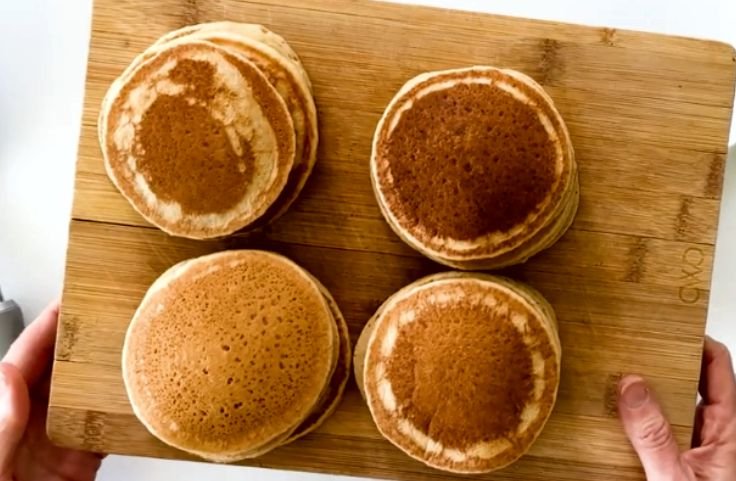Struggling with gummy or dense cassava pancakes? Get expert tips to fix common mistakes and achieve perfectly fluffy, golden results every time, without the frustration.
You’re not alone if your cassava flour pancakes keep turning out gummy, flat, or hard to flip.
Cassava flour behaves differently from other gluten-free flours. It soaks up more liquid and lacks the structure that wheat flour gives to pancakes.
That means what works in a regular recipe won’t always work here.
But with a few smart adjustments, you can get light and fluffy results without the guesswork.
In this guide, you’ll find clear fixes for common issues like stickiness, denseness, and uneven cooking.
If you’ve tried a cassava flour pancake recipe and ended up frustrated, don’t toss the idea just yet.
With a better understanding of what’s going wrong, you’ll soon enjoy pancakes that taste and feel right.
Table of Contents
- Why Cassava Flour Pancakes Can Be Tricky
- Problem: Pancakes Are Gummy or Sticky Inside
- Problem: Pancakes Are Too Dense or Heavy
- Problem: Pancakes Break Apart Easily
- Problem: Pancakes Stick to the Pan
- Pro Tips for Fluffy, Golden-Brown Pancakes
- Final Pancake Troubleshooting Checklist
- Conclusion
Why Cassava Flour Pancakes Can Be Tricky
Cassava flour pancakes can be hard to perfect if you’re used to wheat or almond flour.
The texture, moisture, and structure behave differently, and that means your usual tricks might not work here.
Cassava flour absorbs more liquid than you expect
If your batter feels fine but your pancakes turn out dry or rubbery, too much cassava flour is likely the reason.
This flour soaks up liquid fast, and even small measurement errors can throw things off.
You’ll need to find the right flour-to-liquid balance. Start with a thicker batter than normal, but add more milk or water if it looks stiff after resting.
The batter thickens as it sits on the counter
Your cassava pancake batter might look perfect at first, then feel like dough five minutes later.
That’s because cassava flour keeps absorbing moisture over time.
Let the batter rest before cooking, then stir in a splash of liquid if it gets too thick.
This simple habit helps with spreadability and reduces stickiness on the pan.
No gluten means you need a proper binder
Cassava flour doesn’t have gluten to hold it together. Without a binder, your pancakes may crumble or break when flipping.
Eggs work well, but you can also try flaxseed meal or chia gel if you’re avoiding eggs.
Just one missing binder can ruin texture, so don’t skip it, even in a “simple” recipe.
Overmixing makes your pancakes heavy
You might think mixing well gives a smoother batter, but with cassava flour, it can lead to thick and chewy results.
Mix just until your ingredients combine. If you overmix, the batter gets gluey fast, and your pancakes might stay dense in the center no matter how long you cook them.
Pan temperature affects structure and flip
A cold or underheated pan will leave your pancakes gummy in the middle and stuck to the surface.
Preheat your pan fully before adding the batter. A medium setting usually works best.
Wait until bubbles form and edges look firm before flipping. Rushing the flip can tear the pancake or make it stick.
Related Posts
Cassava Pancake Mix vs Cassava Flour Pancake Mix
Vegan Cassava Flour Pancake Recipe
Cassava Pancake Recipe Using Grated Cassava
Cassava Pancake vs Cassava Flour Pancake
Problem: Pancakes Are Gummy or Sticky Inside
Cassava flour pancakes turning out gummy or sticky inside? You’re not the only one.
This usually comes down to too much liquid in the batter or not cooking them long enough.
Let your batter rest before cooking
When you give your cassava flour batter time to sit, the flour absorbs liquid more evenly.
This helps prevent a gluey center and gives your pancakes a better structure.
Letting it rest for 10 to 15 minutes allows the mixture to thicken naturally and keeps your pancakes from feeling undercooked on the inside.
Don’t skip this step. It’s simple and it works.
Preheat the pan to the right temperature
If your pan is too cool, the outside will brown slowly and the inside will stay wet.
Always preheat your pan first. You can test the surface by flicking in a few drops of water.
If they sizzle and disappear fast, it’s ready. A hot surface helps cook the center all the way through while giving you that golden finish.
Adjust the liquid in your batter
Cassava flour soaks up more water than you might expect. Too much liquid will make your pancakes cook unevenly and feel sticky.
If the batter looks too loose even after resting, add a spoonful of flour and stir gently.
If it’s too thick, add a splash of milk or water. Small changes can fix big problems.
Problem: Pancakes Are Too Dense or Heavy
If your cassava flour pancakes feel heavy instead of light and fluffy, the problem usually comes down to missing lift or overworked batter.
But it’s fixable with a few simple changes.
Use baking soda and acid to give lift
To help your pancakes rise, combine baking soda with an acid like lemon juice or vinegar.
This combo releases carbon dioxide, which makes the batter airy.
Use about one teaspoon of baking soda per cup of cassava flour, plus one tablespoon of acid.
This chemical reaction happens fast, so cook the batter soon after mixing to keep that fluff locked in.
Don’t overmix your pancake batter
Overmixing crushes air pockets and leaves you with thick, chewy pancakes.
Cassava flour doesn’t have gluten, but it still tightens up when stirred too much.
Once your wet and dry ingredients are just combined, stop mixing. A few lumps are fine and help give the batter some bounce while it cooks.
Problem: Pancakes Break Apart Easily
If your cassava flour pancakes keep falling apart, the batter probably lacks enough structure or moisture.
This happens when there’s no proper binder or when the batter dries out too fast.
Add eggs or flaxseed gel for structure
Cassava flour needs a binder to hold everything together. Eggs work well because they help with both binding and moisture.
If you’re not using eggs, flaxseed gel is a solid option.
Just mix one tablespoon of ground flaxseed with three tablespoons of water and let it sit for ten minutes.
This forms a gel that helps your pancakes stay intact and easier to flip.
Adjust batter consistency for better texture
A thin or overly dry batter makes pancakes fall apart. Cassava flour soaks up more liquid than you might think, so start thick but not stiff.
If the batter feels loose or watery, stir in a little extra flour. For added support, mix in a teaspoon of tapioca starch or arrowroot powder.
These additions help your pancakes hold their shape without making them dense.
Problem: Pancakes Stick to the Pan
Sticky pancakes can ruin your flow in the kitchen. When your cassava flour pancakes cling to the pan, flipping becomes frustrating and the texture suffers. But this problem is easy to fix.
Make sure your pan is properly heated
A cold pan almost guarantees the batter will stick. Before you pour, give your pan time to warm up.
Use medium heat and let it sit for a few minutes. You can test the temperature with water drops.
If they sizzle and vanish fast, your pan is ready. This small habit helps your pancakes cook evenly and release cleanly.
Use the right pan for cassava flour pancakes
Your choice of pan matters more than you think. Non-stick or well-seasoned cast iron pans work best.
Stainless steel, unless perfectly preheated, can make pancakes stick and tear.
If you prefer cast iron, keep it seasoned with oil after each use.
A smooth, oiled surface gives your pancakes room to cook and flip without trouble.
Grease lightly between each batch
Even with non-stick pans, adding a bit of oil or butter between batches helps.
Cassava flour batters benefit from a thin layer of grease to avoid sticking.
Use oils like coconut or canola that can handle heat well.
Too much oil can fry the batter, but a quick swipe with a paper towel does the trick.
Pro Tips for Fluffy, Golden-Brown Pancakes
If you want your cassava flour pancakes to turn out light and golden every time, a few small changes in how you prep and cook can make a big difference.
Add sparkling water to lift the batter
Using sparkling water instead of regular water adds bubbles that help your pancakes rise as they cook.
The carbonation gently lifts the batter, making it softer and more airy.
Stir it in just before cooking, and don’t overmix.
You’ll get a lighter texture without needing extra ingredients or complicated steps.
Whip egg whites for extra fluff
Separate your eggs and beat the whites until they form soft peaks. Then gently fold them into your batter.
This adds air and gives your pancakes a gentle lift. The result is a softer bite and a thicker stack that looks and feels better on the plate.
Let your batter rest before cooking
Letting your cassava flour batter sit for about 10 to 15 minutes gives the flour time to soak up the liquid.
This helps the mixture thicken and hold its shape better on the pan.
It also allows the flavors to come together naturally, giving you a better bite in every forkful.
Cook low and slow for golden results
Medium heat works best. If your pan is too hot, the outside will brown too fast and the inside won’t cook through.
Be patient and watch for bubbles before flipping. This keeps your pancakes tender inside with that golden finish you’re after.
Final Pancake Troubleshooting Checklist
Struggling with sticky or flat cassava flour pancakes? Use this checklist to spot what went wrong and fix it fast.
With just a few tweaks, your pancakes can turn out fluffy and smooth every time.
Let your batter rest: it makes everything come together
After mixing, give your cassava flour batter 10 to 15 minutes to rest.
This short break allows the flour to absorb the liquid evenly.
It also helps thicken the batter slightly and gives the starch time to bind with the other ingredients.
Skipping this step can lead to thin, runny pancakes that don’t hold their shape or cook evenly in the pan.
Check your batter consistency: aim for pourable but not watery
Too thick and the pancakes will be doughy. Too thin and they’ll spread out and stick.
You’re looking for a batter that slowly pours off a spoon without dripping like water.
Adjust with small amounts of water or flour until it feels right.
This one change alone can fix many problems, especially with texture and flipping.
Use the right amount of leavening: too little or too much makes a mess
Cassava flour needs a boost to rise well. Baking powder or baking soda helps your pancakes fluff up instead of staying flat.
But too much and they’ll taste off or rise unevenly.
Use about one teaspoon of baking powder per cup of flour as a baseline.
If you’re combining leavening agents, make sure they balance each other.
Add a binder: without one, pancakes can fall apart
Cassava flour doesn’t have gluten, so you need a binder to hold the batter together.
Eggs work well, but if you’re avoiding them, ground flaxseed mixed with water is a reliable swap.
Just one or two eggs per batch usually gets the job done. Too many and your pancakes may turn dense and eggy instead of light.
Preheat your pan properly: temperature matters more than you think
A cold or overheated pan ruins pancakes fast. Medium heat is your safest bet. Test it by dropping a bit of batter. If it sizzles gently, you’re ready.
Letting your pan warm up slowly gives you even browning and keeps the pancakes from sticking.
Adjust the heat as needed between batches to avoid burning or undercooking.
Watch your moisture balance: more liquid doesn’t mean better pancakes
Don’t keep adding liquid, thinking it will fix dryness. Too much and your batter won’t cook through properly.
Instead, start with a solid ratio, and only tweak it if your batter looks too stiff.
Moisture affects thickness, browning, and how easy it is to flip without tearing. A balanced mix gives you better results from start to finish.
Conclusion
If your cassava flour pancakes have been gummy, dense, or just plain hard to cook, you’re not alone.
This flour works differently than what you’re used to and demands a different approach.
But once you understand how it behaves, how much liquid it needs, how long to rest the batter, and how to bind it properly, things get easier.
A few small changes can lead to pancakes that are fluffy, golden, and easy to flip.
Use the tips and fixes in this guide as a checklist the next time you cook.
With a little practice and the right method, you’ll start getting results that feel right and taste even better, every time.

Chimeremeze Emeh is a writer and researcher passionate about Africa’s most transformative root crop—cassava. Through his work at cassavavaluechain.com, he explores the entire cassava industry, from cultivation and processing to its diverse applications in food, health, and industrial use.
He also writes for palmoilpalm.com, where he shares his extensive experience and deep-rooted knowledge of palm oil, covering red palm oil, palm kernel oil, and refined products. His work there reflects his lifelong connection to agriculture and his commitment to promoting sustainable value chains in Africa.
Driven by curiosity and purpose, Chimeremeze aims to shed light on how cassava continues to empower communities, strengthen food systems, and link traditional farming wisdom with modern innovation.

